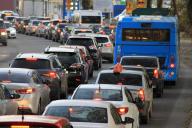Details
- Publication date
- 4 June 2022
Description
A European Environment Agency (EEA) analysis, published today, shows how total greenhouse gas emissions from both passenger cars and heavy goods vehicles have increased in Europe, despite better engine efficiency and use of biofuels
The EEA assessment ‘Decarbonising road transport — the role of vehicles, fuels and transport demand’ analyses the driving factors for greenhouse gas emissions from passenger cars and heavy goods vehicles in the European Union (EU). The new report is part of the ‘Transport and environment reporting mechanism’ (TERM) series of annual assessments.
According to EEA data, CO2 emissions from passenger cars in the 27 EU Member States increased by 5.8 %, and emissions from heavy goods vehicles increased by 5.5 %, from 2000 to 2019.
The main reason for the total increase in both car and truck emissions was growing transport volumes, which have only partially been offset by better fuel efficiency and the use of biofuels, the EEA assessment shows.
Adding to the challenge of growing transport volumes, Europe has not yet shifted to greener transport modes. During the past two decades, cars have maintained and slightly increased their dominant share in land-based passenger mobility while trucks have done the same in freight transport.
Improving vehicle CO2 efficiency, including increasing the share of electric vehicles, is expected to play an important role in decarbonising passenger and freight transport — especially when coupled with continued decarbonisation of electricity and fuel production.
However, the EEA assessment also finds that decarbonising Europe’s mobility system requires methods beyond efficiency gains in road transport. This includes higher occupancy rates, for example through ride-sharing, and fuller cargo loads, as well as, curbing demand and shifting to greener transport modes: walking, cycling, buses, trains, and inland navigation.
To support the overall climate neutrality target, the EU goal is to reduce greenhouse gas emissions from transport by 90% by 2050, compared with 1990 levels
Image par Alexander Grishin de Pixabay

